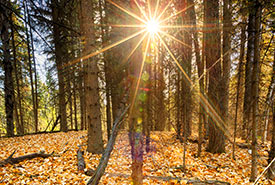Strong and free: Releasing a red-tailed hawk at Bunchberry Meadows

Red-tailed hawk (Photo by Bill Hubick)
This fall, WILDNorth (formerly the Wildlife Rehabilitation Society of Edmonton) staff were invited by the Nature Conservancy of Canada (NCC) to release a red-tailed hawk at NCC’s Bunchberry Meadows property in Alberta — an absolutely gorgeous, newly acquired area just west of the Edmonton.
The day was sunny and breezy, and the hawk was restless, somehow sensing that something exciting was about to happen. We carried it inside a soft-sided dog carrier to the middle of the property, and awaited NCC’s staff and members of NCC's national board of directors to join us after their walk around Bunchberry Meadows.

Bunchberry Meadows Conservation Area, AB (Photo by Kyle Marquardt)
Bunchberry Meadows holds a special place in my heart. The WildNorth team and I were first invited to release a bird here a few years ago, and were privileged to explore the property and really get a feel for its unique features. Personally, I donated what I could afford to the acquisition of the area because I believe it needs to be protected and felt NCC should be the organization to do it.
WildNorth’s other connection with NCC is our unique partnership at the Fleming property in Parkland County, where our rural rehabilitation centre is located. This relationship was established in 2009, and has allowed our non-profit wildlife rehabilitation centre a chance to spread its wings.
WildNorth originally started in a garage as the Alberta Bird Rescue Association. It has since gone from a small, backyard wildlife rescue to an essential service to the community of Edmonton and surrounding area. It’s also the most northerly wildlife rehabilitation facility in Alberta. WildNorth now admits more than 2,500 injured wildlife annually. Some of these injuries are caused by cars, window strikes, power lines, barbed wire, poison, gunshots and domestic predators (dogs and cats).
Wildlife rehabilitators try to recover and return wild animals that are injured, orphaned or otherwise compromised (contaminated feathers, trapped in holes, etc.) back to their natural habitats.
Whether it’s individual animals or wildlife populations as a whole, some of the most direct threats to species’ well-being are from the impact of human beings on nature. Over time, humans have vastly altered natural landscapes and now wildlife has to navigate through these changes.
This particular red-tailed hawk was seen by a member of the public to be struggling and was easily captured by WildNorth, which was a sure sign that something was wrong. Although there were no obvious wounds and a quick X-ray revealed no broken bones, there was a strong suggestion that the hawk had eaten something that didn’t agree with it; it later regurgitated a ground squirrel.
Luckily for the hawk, its time in captivity was short. Once released, it wasted no time taking to the air. It flew off away from us as fast as it could, while onlookers from NCC marvelled at its beauty and shared in its excitement that it was free again.
Check out the video of the release below:


